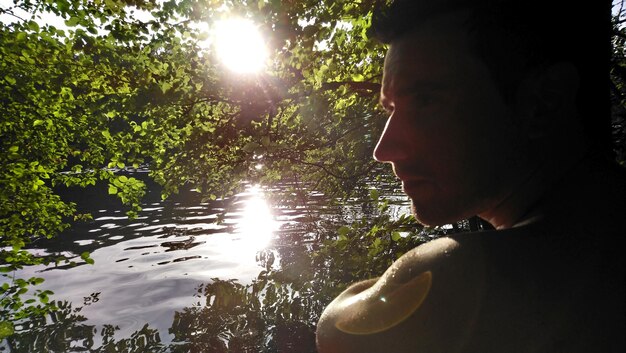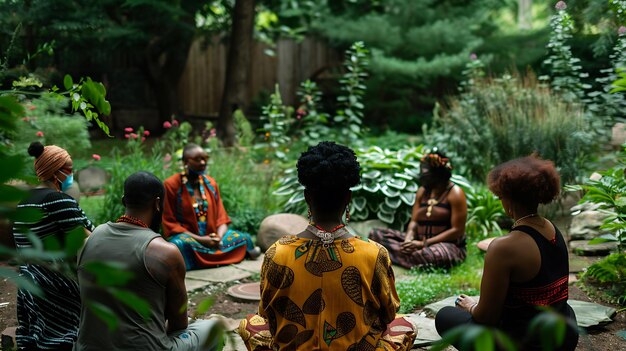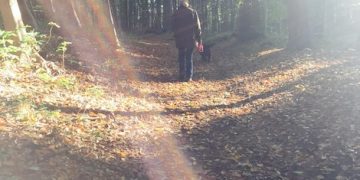Nature Therapy: Effective Stress Reduction & Mental Well-being (2025 Update)

Nature therapy, also known as ecotherapy, increasingly demonstrates its effectiveness in reducing stress and enhancing mental well-being, with 2025 updates highlighting its accessibility, affordability, and positive impact on diverse populations through various outdoor activities.
Feeling stressed? Wondering if a walk in the park can really make a difference? Let’s dive into the 2025 update on whether nature therapy is effective for reducing stress and improving mental well-being.
Understanding Nature Therapy: The Basics
Nature therapy is a broad term encompassing various activities that involve interacting with the natural world to promote mental and physical health. It’s not just about taking a Sunday stroll; it involves intentional practices to connect with nature.
From forest bathing to wilderness therapy, there are many ways to engage. Let’s explore the core components of this increasingly popular approach to wellness.
What Defines Nature Therapy?
Nature therapy, also known as ecotherapy, involves structured activities in natural environments designed to improve mental and physical health. Here’s what sets it apart:
Intentional Interaction
It focuses on purposeful engagement with nature, rather than passive exposure. Activities are designed to foster a mindful connection.
Qualified Guidance
Many forms of nature therapy are guided by trained professionals. These experts help participants maximize the therapeutic benefits.
Diverse Settings
Sessions can take place in forests, parks, gardens, or even urban green spaces, adapting to individual needs and local resources.
- Mindfulness Practices: Activities like mindful walking or nature meditation help reduce stress.
- Horticultural Therapy: Gardening and plant care can improve mood and cognitive function.
- Adventure Therapy: Wilderness expeditions promote resilience and self-esteem through challenging physical activities.
Nature therapy’s appeal lies in its holistic approach, recognizing the interconnectedness between human well-being and the health of the planet.
In essence, nature therapy offers a structured way for individuals to harness the restorative power of the natural world. As we move forward, understanding its core components is crucial in appreciating its potential benefits.
The Science Behind Nature’s Calm
Why does being in nature make us feel so good? It’s not just a feeling; science is increasingly uncovering the mechanisms behind nature’s calming effects on our minds and bodies.
From reduced stress hormones to increased feelings of happiness, here’s a look at the science-backed benefits.
Biological Mechanisms
Research has revealed that spending time in nature triggers several physiological responses that contribute to stress reduction and improved mental well-being.
Cortisol Reduction
Studies have shown that exposure to natural environments can significantly lower cortisol levels, the hormone associated with stress.
Increased Natural Killer (NK) Cell Activity
Forest bathing, a Japanese practice known as Shinrin-Yoku, has been linked to increased activity of NK cells, which play a crucial role in the immune system.
Enhanced Parasympathetic Nervous System Activity
Being in nature activates the parasympathetic nervous system, promoting relaxation and reducing the body’s “fight or flight” response.
- Phytoncides: Trees emit these airborne chemicals, which have been found to boost immune function and mood.
- Vitamin D: Sunlight exposure increases Vitamin D levels, crucial for bone health, immune function, and mental well-being.
- Negative Ions: Found in abundance near waterfalls and forests, these ions can improve mood and reduce stress levels.
These biological mechanisms collectively contribute to the profound sense of calm and rejuvenation that many people experience in natural settings.
By understanding the science behind nature’s calm, we can better appreciate the potential benefits of incorporating nature therapy into our lives. It’s not just about feeling good; it’s about supporting our mental and physical health through natural means.

Types of Nature Therapy
Nature therapy isn’t a one-size-fits-all approach. It encompasses a variety of activities and practices, each with its unique focus and benefits.
Whether you prefer a gentle garden stroll or an adventurous wilderness expedition, there’s a form of nature therapy that suits your preferences.
Exploring the Variety
From structured programs to individual practices, nature therapy offers diverse ways to connect with the natural world and enhance well-being.
Forest Bathing (Shinrin-Yoku)
Originating in Japan, this practice involves mindfully immersing oneself in the atmosphere of the forest. It’s about engaging all senses to experience the forest environment.
Wilderness Therapy
Often used for therapeutic interventions, wilderness therapy involves multi-day expeditions in natural settings. It can help individuals build resilience, self-esteem, and coping skills.
Horticultural Therapy
This involves gardening and plant-based activities to improve mental and physical health. It can be particularly beneficial for individuals with cognitive or physical impairments.
- Animal-Assisted Therapy: Interacting with animals in natural settings can reduce stress and improve mood.
- Adventure Therapy: Activities like hiking, climbing, and kayaking can promote personal growth and teamwork.
- Green Exercise: Combining physical activity with exposure to nature enhances both physical and mental health benefits.
The key to effective nature therapy lies in finding the type that resonates with your personal preferences and needs. Each approach offers unique opportunities for healing and growth.
As nature therapy continues to evolve, understanding its diverse forms is essential in maximizing its impact. Whether you’re looking for a tranquil escape or a challenging adventure, nature offers a therapeutic path for everyone.
Nature Therapy in 2025: What’s New?
As we move into 2025, nature therapy continues to evolve, integrating new technologies, reaching wider audiences, and refining its evidence-based practices.
From virtual nature experiences to community-based programs, here’s what’s new and noteworthy in the world of nature therapy.
Technological Integration
Technology is playing an increasingly important role in making nature therapy more accessible and effective. From virtual reality to AI-powered apps, tech is enhancing our connection with nature.
Virtual Reality (VR) Nature Experiences
VR technology offers immersive nature experiences for people who cannot access real natural environments due to mobility issues or geographical limitations.
AI-Powered Apps for Nature Therapy
These apps provide personalized guidance, track progress, and offer insights into the effectiveness of nature-based interventions.
Telehealth Integration
Telehealth platforms are incorporating nature therapy sessions, allowing therapists to guide clients through outdoor activities remotely.
- Wearable Technology: Track physiological responses to nature, like heart rate variability, to personalize interventions.
- Augmented Reality (AR): AR apps overlay digital information onto real-world settings, enhancing engagement with nature.
- Biometric Sensors: These monitor stress levels and provide real-time feedback during nature therapy sessions.
Technology’s role in nature therapy is not about replacing real experiences but enhancing them. It’s about making nature more accessible and tailoring interventions to individual needs.
In 2025, the integration of technology in nature therapy continues to bridge the gap between the digital world and the natural environment. These advancements offer new ways to harness the power of nature for mental and physical well-being.

Making Nature Therapy Accessible to All
One of the significant advancements in nature therapy is the increasing focus on making it accessible to diverse populations, breaking down barriers related to cost, location, and physical ability.
From community gardens to adaptive programs, here’s how nature therapy is becoming more inclusive.
Community-Based Programs
Local initiatives and collaborations are bringing nature therapy to underserved communities, creating opportunities for everyone to experience its benefits.
Urban Green Spaces
Transforming vacant lots into community gardens and parks provides accessible nature experiences in urban environments.
Adaptive Nature Therapy
Programs tailored to individuals with disabilities ensure that everyone can participate in nature-based activities, regardless of their physical or cognitive limitations.
Affordable Options
Free or low-cost nature therapy sessions, often led by volunteers or community organizations, make these interventions accessible to individuals with limited financial resources.
- Mobile Nature Therapy: Bringing nature to people through mobile gardens and traveling programs.
- Nature Prescriptions: Healthcare providers prescribe nature visits as part of treatment plans, often covered by insurance.
- Multicultural Programs: Culturally sensitive nature therapy that respects diverse traditions and beliefs.
Breaking down these barriers is crucial for ensuring that everyone can benefit from the healing power of nature. Inclusivity and accessibility are key to promoting health equity through nature therapy.
As we move forward, the commitment to making nature therapy accessible to all continues to drive innovation and collaboration. By addressing the barriers that limit participation, we can unlock the full potential of nature for promoting well-being for everyone.
Overcoming Challenges and Future Directions
While nature therapy offers immense potential, it also faces challenges that need to be addressed to ensure its sustainable and effective implementation. Let’s explore these challenges and future directions.
From research gaps to standardization issues, here’s what needs to happen to take nature therapy to the next level.
Research and Standardization
To gain wider acceptance and integration into healthcare systems, nature therapy needs to be supported by rigorous research and standardized practices.
Standardized Protocols
Developing clear guidelines and protocols for nature therapy interventions ensures consistency and allows for better comparison of research findings.
Longitudinal Studies
More long-term studies are needed to assess the lasting effects of nature therapy and identify the most effective interventions for different populations.
Addressing Research Gaps
Further research is needed to explore the specific mechanisms through which nature impacts mental and physical health, as well as to identify the optimal dosage and types of nature exposure.
- Training and Certification: Establishing professional standards for nature therapists ensures qualified practitioners.
- Policy Integration: Advocating for the inclusion of nature therapy in public health policies promotes wider adoption.
- Sustainability: Implementing practices that protect and preserve natural environments ensures the long-term availability of nature therapy resources.
Addressing these challenges is crucial for realizing the full potential of nature therapy. By investing in research, standardization, and sustainability, we can ensure that nature continues to be a valuable resource for health and well-being.
Looking ahead, the future of nature therapy depends on addressing these challenges and embracing opportunities for innovation. By working together, we can harness the power of nature to create healthier and more resilient communities.
| Key Point | Brief Description |
|---|---|
| 🌿 Stress Reduction | Nature therapy lowers cortisol levels, reducing stress and anxiety. |
| 🧠 Mental Well-being | Improves mood, boosts self-esteem, and enhances cognitive function. |
| 🏞️ Accessibility | Growing efforts to make nature therapy available to diverse populations. |
| 🔬 Scientific Support | Increasing research validates the benefits of nature therapy. |
Frequently Asked Questions About Nature Therapy
▼
Nature therapy encompasses various activities like forest bathing, gardening, and wilderness expeditions, all designed to improve mental and physical well-being through intentional interaction with the natural world.
▼
Exposure to nature lowers cortisol levels, activates the parasympathetic nervous system (promoting relaxation), and increases activity of natural killer (NK) cells, which boost the immune system.
▼
Walking in a local park, gardening, spending time in community green spaces, and participating in guided nature walks are all accessible forms of nature therapy you can easily incorporate into your routine.
▼
Yes, technology like virtual reality, AI-powered apps, and wearable sensors are increasingly used to enhance nature therapy, making it more accessible and personalized, especially for those with limited access.
▼
Look for therapists with certifications in ecotherapy or wilderness therapy. Check with local healthcare providers and community organizations for referrals to qualified professionals in your area.
Conclusion
In conclusion, the 2025 update reaffirms that nature therapy is effective for reducing stress and improving mental well-being, offering diverse, accessible, and increasingly technologically-enhanced options for individuals seeking natural ways to enhance their health.





